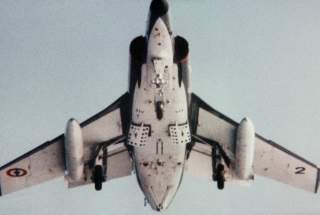5 French Super Etendard Fighter-Bombers Are on the Move
Five ex-French navy Super Etendard fighters have arrived at the port of Bahia Blanca in Argentina. The subsonic fighter-bombers eventually will equip the Argentine navy and, by the end of 2019, could be the most sophisticated warplanes in the Argentine military.
Five ex-French navy Super Etendard fighters have arrived at the port of Bahia Blanca in Argentina. The subsonic fighter-bombers eventually will equip the Argentine navy and, by the end of 2019, could be the most sophisticated warplanes in the Argentine military.
Buenos Aires’ acquisition of the old French jets represents a minor turn-around in the fortunes of a military that long has struggled to keep planes in the air.
The $13-million Super Etendard purchase hasn’t been without its own complications, Scramble on May 12, 2019 reported. “All five were scheduled to be offloaded on May 9, 2019, but this turned out to be impossible due to a strike in the harbor at the multipurpose dock of the company Patagonia Norte, in Ingeniero White.”
“It is expected that the aircraft will be unwrapped this weekend,” Scramble added. “They will be presented in an official ceremony on May 13, 2019. The Argentine minister of defense as well as senior leaders of the Argentine navy will attend the ceremony.”
The Super Etendards originally entered service with the French navy in the late 1970s or early 1980s. The French in the 1990s upgraded the carrier-capable jets to the Super Etendard Modernize standard before retiring them in 2016.
The Argentine navy previously operated 14 Super Etendards, acquiring five of them in time for service during the 1982 Falklands War. Argentine Super Etendards firing Exocet anti-ship missiles sank two British vessels, a destroyer and a cargo ship. By late 2017 none of the original Super Etendards were flightworthy, according to Flight’s 2018 survey of world air arms.
The navy’s efforts to rebuild its fighter fleet come amid a wider struggle on the part of the Argentine defense ministry to maintain viable air components. British forces in 1982 shot down around a third of Argentina’s 400 warplanes, but in subsequent decades funding woes and mismanagement exacted an even greater toll.
By late 2015 Buenos Aires could muster fewer than 250 warplanes including a few Vietnam War-vintage, subsonic A-4s and equally aged, but supersonic, French-made Mirages. Even the planes that could fly lacked modern systems.
“The entire air force fleet lacks modern avionics and systems, and still uses analog equipment,” Santiago Rivas wrote in a 2015 edition of Combat Aircraft magazine. “Aircraft have missed out on self-protection equipment, including radar warning receivers, chaff/flare dispensers and so forth.”
“Critically, only the A-4s have an aerial refueling capability and there are just two tankers. [Airborne early warning] capability is nonexistent,” Rivas added, “despite the fact that controlling the airspace of such a large country is a major and vital task.”
The Mirages left service in mid-2015. To rebuild its supersonic fighter capability, Buenos Aires considered buying new Gripens from Brazil, old American F-16s, second-hand Mirage F.1s from Spain and new FC-1s from China before finally settling on 14 used Israeli Kfir Block 60s, priced to move at $350 million including several years of maintenance.
It seemed like the air force might be on the rebound. But not everyone was happy, especially Brig. Mario Roca, who in late 2015 was the air force’s number-three officer. Roca argued that the Israeli fighters lacked modern weapons system. Only six of them would be equipped with radars, he pointed out.
In any event, the United States refused to grant an export license for the Kfir’s American-made engines. Argentina was left with no supersonic fighters.
By 2018 Argentina also had retired all of its A-4s. The flying branch had wanted to upgrade the fighters to serve until 2022, but a lack of spares rendered them unflyable.
Today just a handful of weapons-capable warplanes remain in Argentine service, including around two dozen each subsonic IA-63 attack jets and IA-58 counterinsurgency planes. But the IA-58s also are slated for imminent retirement.
In the context of the Argentine military’s long unilateral disarmament, acquiring five old Super Etendards is a big deal. At least they can fly and fight.
David Axe serves as Defense Editor of the National Interest. He is the author of the graphic novels War Fix, War Is Boring and Machete Squad.

